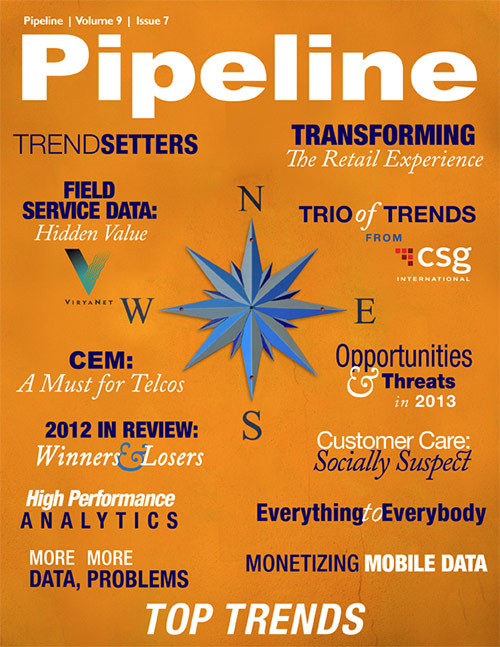The Top Trendsetters of 2012
SOCIAL MEDIA

Jeffrey Hirsch
EVP & CMO, residential services
Time Warner Cable
Around 2009, as companies began to see customers air their frustrations on Facebook, Twitter and other social-media streams, Time Warner Cable took the channel and the challenge seriously, signing up for a Twitter handle and adding a support tab to its Facebook page. According to Ogilvy in New York, TWC resolved or referred 30,000 customer issues via Twitter, and the company got a 75 percent response rate when proactively reaching out to customers who complained on the social-media site.
In July 2011 Jeffrey Hirsch took over the role of chief marketing officer for Time Warner Cable and was named senior vice president as well. He soon oversaw the launch of the company’s iPad app, and under his leadership, both the New York City and Los Angeles Metro divisions launched Time Warner Cable Technology Centers.
In October TWC launched Social One, an application to help users simplify their social lives. Social One is a one-stop destination that allows customers to access social-media platforms and instant-messaging services directly from their desktops. It is a free application that integrates with Facebook, Twitter, LinkedIn, Foursquare, YouTube, AIM, and other social sites; users can easily share links, images and video from the Web with all of their social networks at the same time. Social One also includes a feature called Socialzine that lets users view their social networks and consumer-portal content in a magazine-style layout.
While serving as a way for customers to keep up with all their online presences, Social One also provides TWC with a sticky way of staying in the loop with those presences and better understanding the needs and behaviors of its users. Ogilvy says Facebook has exceeded 1 billion users, 200 million of whom actively post content and read that of their friends. Forty percent of the world’s Internet users are on Facebook; it is a channel that can’t be ignored, and Hirsch and company aren’t.
UNIFIED COMMUNICATIONS

Jason Cook
Chief architect and CTO
BT Americas
Earlier this year Jason Cook penned an article for Fortune magazine in which he described a day in the life of what he calls digital natives, the multitasking, “always on” social
butterflies of the business world who are proving that the long-awaited, sometimes maligned world of unified communications has already arrived. Business users are simultaneously using any and all
means necessary to communicate, and the service providers who connect them and the enterprises that employ them have no choice but to catch up and try to support them.
“Enhanced connectivity, together with advances in technology such as the adoption of smartphones and tablets, the emergence and subsequent proliferation of social networks, have all changed our lives to a large extent. But the challenge remains to unify and integrate these components,” Cook said.
He believes that as unified communications continues to evolve, digital natives will push for the consumerization of IT and access to social networks from corporate networks as part of their communications diet. He said there is “no beating back the tide as digital natives continue to push, pull and smuggle their own choice of technology into work. Every large organization must face the reality of the situation, accept what is happening and start to lead.”
BT Americas began the year with the launch of its enterprise class-hosted Microsoft Lync Unified Communications platform pilot for U.S. enterprise customers. The launch was out of its Irvine, Texas, data center. Cook said the pilot environment was designed to address the unique customer requirements for a Lync-based “cloud”-managed service. It also introduced customers to a low-risk opportunity to evaluate a production-class Lync environment.
BT Global Services followed that up in October by completing its unified communications portfolio with the release of BT One Cloud for Microsoft Lync, which provides instant messaging, presence, audio, video, and Web conferencing and voice to enterprise customers. BT’s hybrid UC strategy includes hybrid-architecture consulting services to advise customers on developing a roadmap for Microsoft Lync, Cisco and other UC migrations and deployments. Unified Communications is just one set of solutions for which enterprises are increasingly turning to the cloud.


















